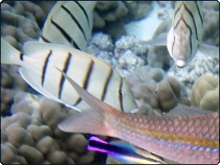Whether it’s mola-mola off Nusa Lembongan, batfish in the Similans off Thailand, Manta Point in the North Male Atoll or cleaner shrimp in Mabul, cleaning stations, where fish go for the human equivalent of a spa treatment, are an integral part of the reef.
Through 13 years of observing cleaner fish on the Great Barrier Reef, Dr. Alexa Grutter and her team from Coral Reef Ecology Laboratory at the University of Queensland in Australia discovered that cleaners dramatically impact on their client fish’s parasite numbers.

The team found that a single cleaner fish could process up to 2,300 fish from any of 130 species per day. During the course of a workday, each cleaner fish can eat up to 1,200 parasites from their clients, with a distinct preference for the tick-like, gnathiid isopod larvae.
Results from experiments showed that in the absence of cleaner fish, parasite numbers on clients increased five-fold when compared with client fish who had access to cleaner fish. The study therefore deduced that parasite infection was the main motivator for this awkward, but mutually beneficial behaviour on the reef.
Other studies show that the tactile stimulation administered through the apparently suicidal service that cleaners render, perhaps has other added benefits too.